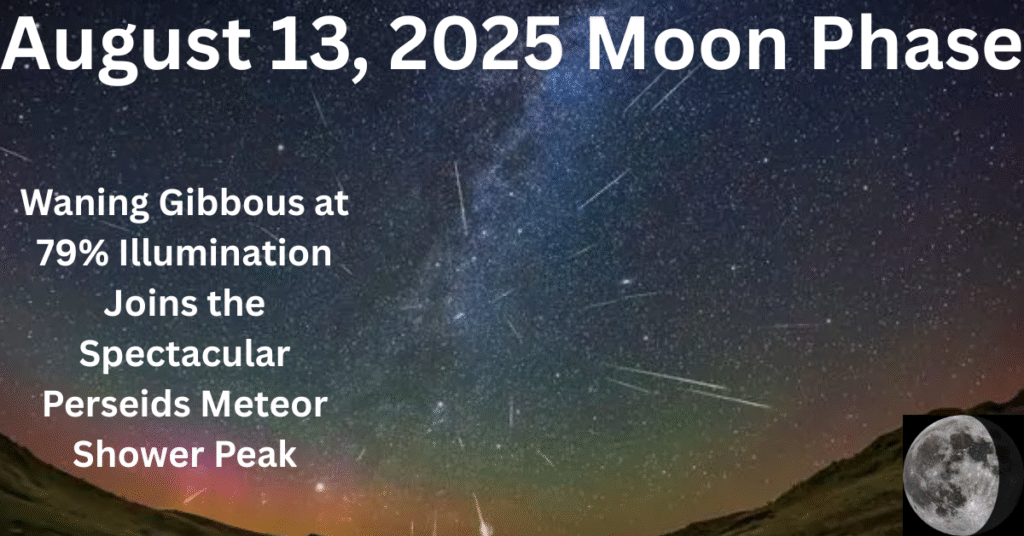
Table of Contents
August 13, 2025 Moon Phase
The Moon never fails to mesmerize skywatchers, and on Wednesday, August 13, 2025, the night sky will offer a double celestial treat — a Waning Gibbous Moon glowing at 79% illumination and the second night of the Perseids meteor shower’s peak. While the Moon’s brightness will dim some meteors, this cosmic combination still promises an unforgettable stargazing experience.
August 13, 2025 Waning Gibbous Moon at 79% Illumination Shines with Perseids Meteor Shower Peak
Today’s Moon Phase — Waning Gibbous
- Illumination: ~79.4%
- Age: 19 days into the 29.5-day lunar cycle
- Visibility: Rises in the late evening and stays visible into the morning
In the Waning Gibbous phase, the Moon is moving away from full illumination and edging toward the Last Quarter. This is the stage where sunlight begins to retreat across the lunar surface from right to left (in the Northern Hemisphere), producing a softer, shadow-rich view of craters and lunar “seas.”
Perseids Meteor Shower — Peak Viewing Tips
The Perseids meteor shower, famous for its bright and fast meteors, is at its annual peak on August 12–13.
- Expected Rate Tonight: ~10–20 meteors per hour (down from the usual 40–50 due to moonlight)
- Best Viewing Times:
- Just after dusk until moonrise for “Earth-grazers” — long, slow-moving meteors near the horizon
- Pre-dawn hours (3 AM–6 AM) facing northeast toward the constellation Perseus
🌟 Bonus Sight: Early risers may also spot a close conjunction of Venus and Jupiter in the pre-dawn sky, adding a planetary sparkle to the night.
What You Can See on the Moon Tonight
With the naked eye:
- Tycho Crater
- Mare Serenitatis
- Oceanus Procellarum (“Sea of Storms”) — covers more than 10% of the Moon’s surface
With binoculars:
- Clavius Crater
- Alphonsus Crater
- Mare Frigoris
With a telescope:
- Apollo 11 landing site
- Rima Ariadaeus (a massive lunar rift)
- Lynn Crater
Lunar Cycle at a Glance
The Moon passes through eight main phases during its 29.5-day orbit around Earth:
- New Moon – Invisible from Earth
- Waxing Crescent – Slim light on the right
- First Quarter – Right half lit
- Waxing Gibbous – More than half lit, approaching full
- Full Moon – Fully illuminated face
- Waning Gibbous – Light decreasing from the right
- Last Quarter – Left half lit
- Waning Crescent – Slim light on the left before returning to New Moon
Key Moon Dates
- Last Full Moon: August 9, 2025
- Next Full Moon: September 7, 2025
Stargazing Checklist for Tonight
✅ Find a dark, open location away from city lights
✅ Bring binoculars or a telescope for detailed Moon views
✅ Check local weather forecasts for clear skies
✅ Arrive early to let your eyes adjust to the dark
Conclusion
On August 13, 2025, the Waning Gibbous Moon will dominate the night sky while the Perseids meteor shower sprinkles shooting stars across the heavens. Though the Moon’s brightness may limit meteor counts, the beauty of its craters, “seas,” and planetary companions makes tonight a night worth watching.
So grab your binoculars, set your alarm, and prepare for a cosmic show that blends lunar elegance with meteor magic.
MoonPhase #WaningGibbous #Perseids2025 #MeteorShower #AstronomyLovers #NightSky #Stargazing #LunarCycle


